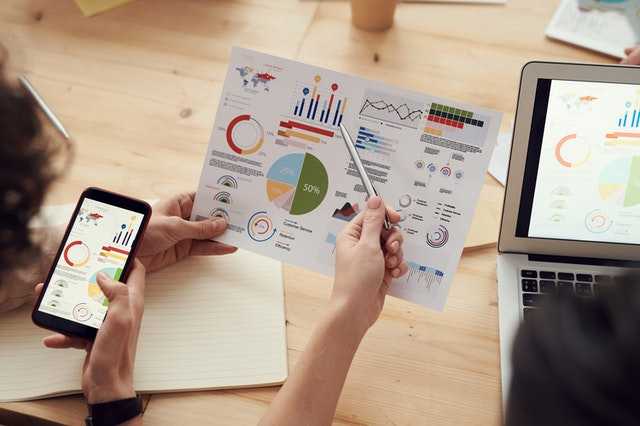Importance Of Data Visualization

Data visualization is the process of converting information into a visual format, such as a map or graph, in order to make data easier to comprehend and extract knowledge from.
The main purpose of data visualization is to make it easier to spot patterns, trends, and outliers in massive data sets.
Data graphics, information analysis, and statistical graphics are all terms that are often used interchangeably.
What is data visualization, and how does it work?
The process of converting broad data sets and metrics into maps, graphs, and other graphics is known as data visualization.
The resulting visual representation of data makes it easier to spot and share real-time patterns, outliers, and new perspectives about the data's content.
Data visualization is one of the steps in the data science process, according to which data must be visualized after it has been obtained, analyzed, and modeled in order to draw conclusions.
.jpg)
Why data visualization is important
Data visualization is part of the larger data presentation architecture (DPA) discipline, which seeks to efficiently define, locate, process, format, and distribute data.
Point #1: Data visualization enhances your message.
Visualizations and pictures of some sort have a stronger effect on their viewers than written words.
This is due to the fact that visuals are more closely linked to memory in the mind.
Visuals often reinforce your message in a special way, making it more memorable to your target audience.
By using these pictorial capabilities, data visualization allows you to more efficiently accomplish your organization's goals.
Using this more effective and convincing tool to present the outcomes of your data analysis process helps you to intensify the message to internal (and external) stakeholders, more effectively uniting everyone around a shared organizational tale.
Point #2: Data Visualization Facilitates Decision-Making
Decisions aren't made in a vacuum. Instead, the data and knowledge you have access to fuel the decision-making process.
You will make better decisions for your company if you feed reliable, impartial data visualizations into your decision-making tools.
The most important aspect, though, is that the data be impartial in order to make informed decisions.
Data visualizations that are done correctly don't use misleading displays to misrepresent the underlying data.
Furthermore, maps and displays should be dynamically and regularly updated with the most up-to-date data to ensure that their decision-making value is maintained.
Point #3: Make predictions based on large-scale trends.
Big data visualization, when combined with advanced analytics, aids in a business case requiring the discovery of trends in data sets and, as a result, patterns in events.
On a bubble map, for example, some of these patterns can be seen with the naked eye.
Others can only be identified through sophisticated algorithms. Executives may use the patterns to make forecasts, identify trends, and develop strategies based on real data rather than assumptions.
Point #4: Allow for real-time monitoring, control, and response.
One of the most significant benefits of big data visualization is that it provides insight and visibility into a company's or organization's processes.
Executives can track in real-time employee results, a customer's buying path, or even something as mundane as energy usage on the premises, depending on which data source we're talking about.
These skills allow for greater process management and the ability to take decisive action if necessary.
Software for Data Visualization
Data visualization software converts data and measurements into charts and graphs, allowing businesses to monitor market metrics and key performance indicators (KPIs) in real-time and gain a deeper understanding of their performance and goals.
.jpg)
Users may use data visualization tools to generate dashboards with scorecards and simple visualizations of company data to monitor trends and KPIs.
Many data visualization tools offer drag-and-drop features as well as other non-technical features, allowing even non-technical users to create necessary dashboards. Some do, however, allow you to build dashboards with code.
Microsoft Power BI
It is a business intelligence tool from Microsoft.
Microsoft Power BI is an excellent example of Redmond's impressive self-service business intelligence (BI) offerings.
When a platform is this strong, the product must live up to the hype, and Microsoft Power BI does just that.
Microsoft Power BI does an excellent job of integrating powerful analytics with a user-friendly UI and impressive data visualization capabilities.
Tableau Desktop.
Tableau Desktop was a pioneer in the field of self-service business intelligence (BI).
It's because of this maturity that it's one of the category's three Editors' Choice winners.
Tableau has been under pressure to change over the years as a result of new entrants, as well as the proliferation of Big Data and the Internet of Things (IoT).
Sisense
Since Sisense is a self-service BI software solution, all data visualization tools are simple to use and allow everyone to produce practical dashboards and reports without relying on IT for ongoing changes or customizations.
Zoho Reports
Zoho Reports is a web-based reporting tool and a part of a larger software package of productivity tools and business applications called Zoho.
However, Zoho Reports, like most of the other apps in Zoho's portfolio, is not reliant on the suite or any of its components; it can be used independently.
However, Zoho has gone to great lengths to make integrating its apps not only simple, but also useful, with a simple integration mechanism and shared toolbars, workspaces, and features.
Its most recent integration, on the other hand, is mostly licensing-driven rather than feature-driven.
Author Bio
Contributor comprises full-time and freelance writers that form an integral part of the Editorial team of Hubslides working on different stages of content writing and publishing with overall goals of enriching the readers' knowledge through research and publishing of quality content.
Article Comments
No Comments!
At present there are zero comments on this article.
Why not be the first to make a comment?
Similar Articles
Sponsor
Search Articles
Experts Column
Latest Articles
Featured Articles
Most Popular Articles

.jpg)











